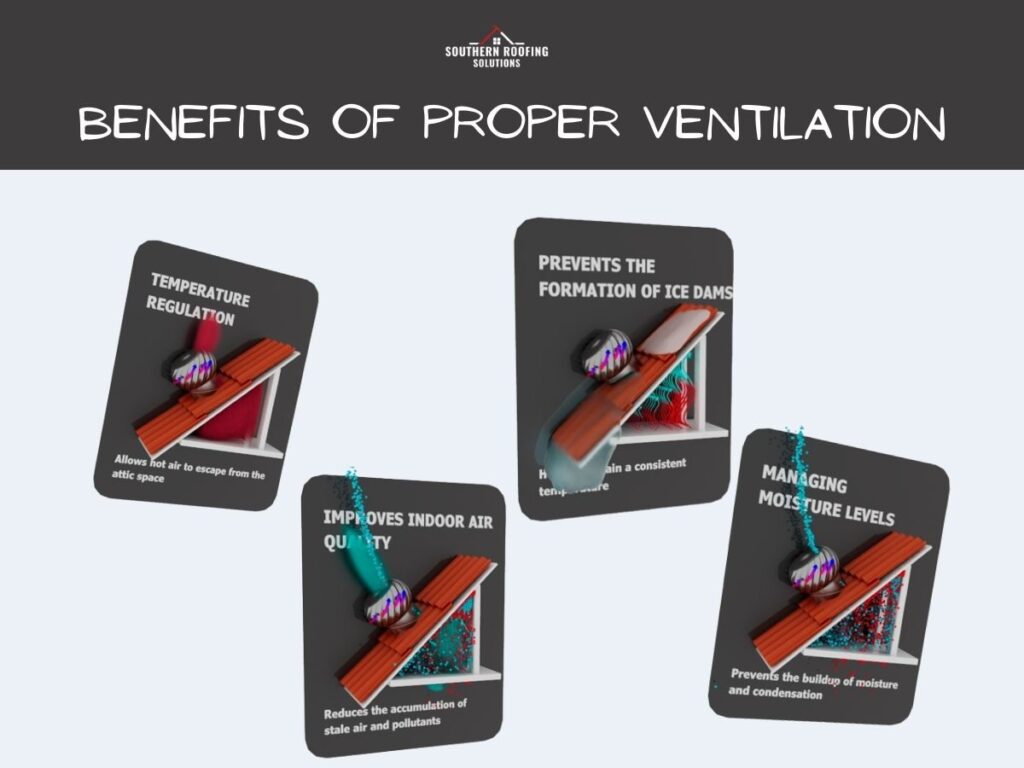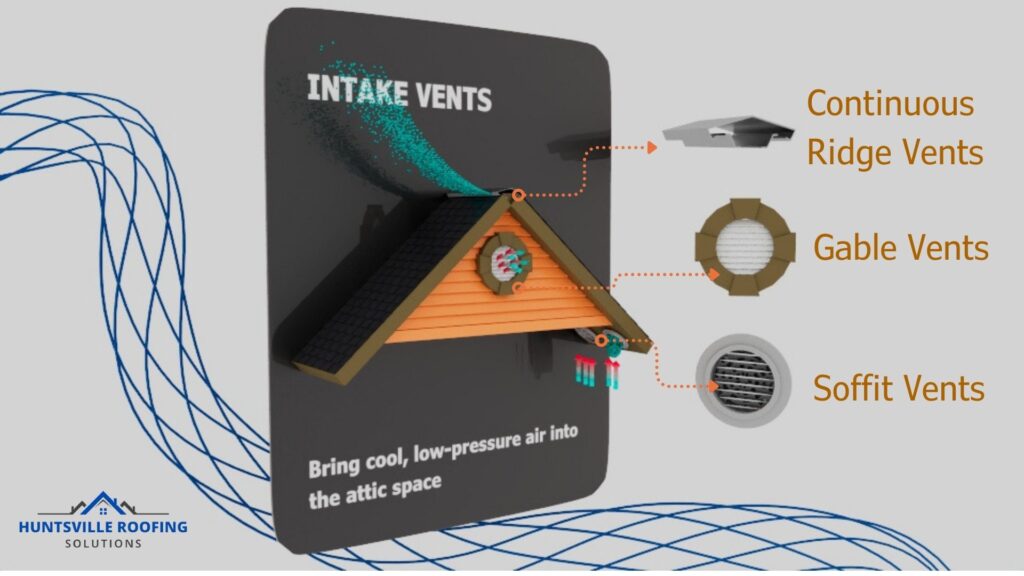Are you fed up with the ever-increasing cost of your AC bills? In that case, you should realize the importance of ventilation in your roof. It's a simple yet practical and efficient method of ensuring your home has adequate air circulation and avoids unpleasant, stagnant, humid summer air.
While many roofing ventilation systems exist, not everyone will work for your roof. This article will help you decide what kind of roof ventilation system is ideal for your home and explain why it is so important.
Ventilation is actually the process of providing a continuous flow of air through a space to remove excess heat, moisture, and pollutants. It is an essential aspect of any roofing system, regardless of the type of roofing profile used.

While certain roofing profiles do not necessarily require ventilation, ensuring optimal performance and longevity is still highly recommended. Proper ventilation is essential for your roofing system.
Without it, you can face a host of issues that can lead to costly repairs and discomfort in your home.
By allowing hot air to escape from the attic space, ventilation prevents excessive heat buildup during summer. This helps to lower the temperature inside your home, reducing the strain on your air conditioning system and ultimately lowering your energy bills.
By allowing for airflow, ventilation helps prevent the buildup of moisture and condensation in the attic. This is important because excess moisture can lead to mold growth, rot, and structural damage over time.
Proper ventilation also improves indoor air quality by reducing the accumulation of stale air and pollutants in living spaces. This can have a positive impact on the health and well-being of your family.
Ventilation helps to prevent the formation of ice dams in cold climates. Ice dams occur when warm air accumulates in the attic and melts snow on the roof, which then refreezes at the eaves.
This can cause water damage to the roof, deck, and interior of your home. Adequate ventilation helps to maintain a consistent temperature, preventing the formation of ice dams.
When it comes to proper ventilation in your roofing system, there are various types of ventilation systems to consider. It's important to note that not all of these vents should be installed in your home at once since you want air flowing in and out in a simple way.
It's worth noting that building codes and regulations may dictate the minimum requirements for roof ventilation in your area. Consulting with a professional roofing contractor can help you determine the most suitable ventilation system for your specific needs and help avoid unnecessary vents.

These vents are typically installed along the eaves or soffit areas of the roof. They work by allowing fresh air to enter the attic, creating a flow of air, and facilitating proper ventilation.
Intake vents are commonly found in various roof profiles, including gable, hip, and shed roofs. Common types of intake vents include:
These vents are essential in bringing cool, low-pressure air into the attic space, especially during the hot summer. They help prevent excessive heat buildup, which can lead to higher energy costs and potential structural damage.
Proper intake vent placement is crucial to ensure efficient airflow. They should be installed evenly along the roof's eaves to allow for a consistent flow of fresh air throughout the attic space.
These vents are typically installed near the ridge of the roof and work in conjunction with intake vents to create a consistent flow of air throughout the attic space.
Hot air naturally rises, and exhaust vents allow this hot air to escape from the attic. This process helps prevent ice dam formation during colder climates and reduces the overall temperature in the attic during the hot summer months.
There are various types of exhaust vents available, including:
Proper installation and placement of exhaust vents are essential to ensure efficient airflow and prevent moisture buildup. They should be installed at the roof's highest point, preferably near the ridge, to allow hot air to escape effectively.
Ridge vents are a popular type of exhaust vent commonly found on residential roofs. They provide continuous ventilation along the roof ridge, allowing hot air to escape and promoting proper airflow throughout the attic space.
One of the advantages of ridge vents is that they can be installed on different types of roof profiles, including gable, hip, and shed roofs. This versatility makes them a popular choice among homeowners and builders.
Ridge vents are typically installed near the peak of the roof, as hot air naturally rises and accumulates at the highest point. By placing the vents along the ridge, they take advantage of this natural airflow, allowing hot air to escape effectively.
Moreover, ridge vents help prevent ice dam formation during colder climates. By removing excess heat from the attic, ridge vents help maintain a consistent roof temperature, preventing snow from melting and refreezing at the eaves, where ice dams can form.
To maximize airflow efficiency, a combination of intake and exhaust vents is highly recommended. This approach ensures a balanced and efficient flow of air throughout your attic space.
Intake vents are typically installed along the lower portions of the roof, such as the soffits or eaves. Their primary function is to allow fresh outdoor air to enter the attic, helping to regulate temperature and humidity levels.
Exhaust vents, on the other hand, are installed near or at the peak of the roof's ridge. As hot air naturally rises, the exhaust vents provide an escape route for this heated air, preventing it from accumulating and causing damage.
By having a combination of intake and exhaust vents, you create a continuous cycle of air circulation. Fresh air enters through the intake vents, while hot air is expelled through the exhaust vents. This helps to maintain a well-ventilated roof and attic space, reducing the risk of moisture buildup, structural damage, and the formation of ice dams.
How do you choose which combination of intake and exhaust vent? Consulting with a roofing professional will help you choose the best options for your specific needs. They will also help you choose according to the various factors around your home.
As mentioned earlier, the right combination or ventilation system can significantly impact your roofing system's overall performance and longevity. Here are some important factors to keep in mind when making your selection:
The design and slope of your roof will play a crucial role in determining the type of ventilation system that is most suitable. For example, a steeply pitched roof may require different types of vents compared to a flat roof.
Choosing a ventilation system compatible with your roof design is important to ensure optimal airflow.
Different regions experience different weather conditions, such as hot summers, cold winters, or high humidity. Understanding the climate patterns in your area will help you choose a ventilation system that can effectively deal with the specific challenges posed by your regional climate.
Choosing a ventilation system that can effectively remove excess heat and moisture from underneath the roof deck, regardless of the type of roofing material used is important.
Asphalt shingles, used in residential roofs, can trap heat if not ventilated, whereby hot attic air can trap and overheat the shingles, accelerating deterioration. This can cause premature aging and costly repairs or replacements.
Metal roofs reflect heat, but direct sunshine can heat them; hence, proper ventilation under metal panels may be needed to help dissipate heat and cool the roof. Clay tiles absorb heat; thus, appropriate ventilation is needed to prevent heat transfer to the roof structure.
Familiarize yourself with the building codes and regulations in your area. These codes often dictate the minimum ventilation requirements for residential buildings.
Ensuring compliance with these codes is not only essential for the safety and structural integrity of your home, but it can also help prevent potential problems when it comes to selling your property in the future.
A well-designed ventilation system can also help reduce energy costs. By allowing hot air to escape during the summer months and preventing heat from building up in the attic, a properly ventilated roof can help keep your home cooler and reduce the need for excessive air conditioning.
This, in turn, can lead to lower energy consumption and cost savings on your utility bills.
When selecting a roof ventilation system, consulting with a professional roofer or ventilation specialist is highly recommended. They can assess your specific needs, take into account all the factors mentioned above, and recommend the best ventilation options for your home.
They will have the knowledge and experience to ensure that your ventilation system is properly installed and meets all the requirements.
When it comes to power sources, homeowners have two main options: solar-powered ventilation or electric-powered ventilation. Each has its advantages and considerations to take into account.
Solar-powered ventilation systems have gained popularity recently due to their energy efficiency and eco-friendly nature. These systems utilize solar panels to power the fans that draw air into the attic or the exhaust vents.
Solar-powered ventilation systems can operate without consuming electricity from the grid by harnessing the sun's power. This not only reduces energy costs but also helps to minimize the carbon footprint of your home.
Additionally, since solar-powered ventilation systems are self-sufficient, they can continue to operate even during power outages, ensuring continuous airflow and optimal ventilation.
On the other hand, electric-powered ventilation systems rely on electricity from the grid to operate the fans. While they may not have the same sustainable benefits as solar-powered systems, they are often more affordable to install upfront.
Electric-powered ventilation systems also provide consistent and reliable airflow, regardless of the weather conditions or the availability of sunlight. Electric-powered ventilation systems can be easily integrated into existing electrical systems, making them a convenient option for homeowners.
Solar-powered ventilation systems may be a more viable option in areas with abundant sunlight. In contrast, electric-powered systems may be more suitable in areas with limited sunlight or high energy costs. It's also important to assess the power requirements of the ventilation system and ensure that your home's electrical system can support it.
While airflow is essential to a snug house, ventilation can be counterproductive if not properly installed and maintained. The ridge vent is essential to any roof because it allows air circulation in and out of the attic.
Water often enters through this opening since most other vents, such as soffit vents, are either facing away from the flow of water down the roof or are positioned to avoid water input. Do you want to keep your roof from leaking from the ridge vent? Here is all you need to know about ridge vent leaks.